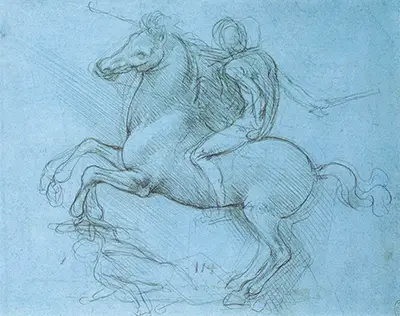The study, which is believed to have been sketched in either 1519 or 1520, follows on from a large volume of work carried out by Da Vinci around 20 years earlier for another monument depicting a horse.
That monument, commonly known as the Sforza horse, also went unbuilt after the plans were destroyed by an advancing French army at the very end of the 15th Century, destroying over 10 years of Da Vinci's work.
This track record mean that it is possible to conclude that Da Vinci had little interest in seeing these statues come to fruition. Instead, it is possible that he treated these sketches more as an intellectual exercise and a challenge for his mind.
Nevertheless, they provide a fascinating insight into Leonardo Da Vinci's wide range of interests and the multiplicity of fields that he dabbled in over the course of his life.
Unlike the earlier Sforza Horse, this equestrian monument depicts a rider on a suit of armour, who is clearly riding into battle. It's also notable that unlike the creature depicted in the abandoned Sforza statue, this horse is beautiful, looking off to the side and feels much more staged than its older counterpart.
In reality, it is highly unlikely that a horse in such a situation would be doing anything other than galloping forward as fast as its legs would allow. This sense of unreality is an interesting change for Da Vinci and clearly places the work closer to the middle of his career than the Sforza horse, a point at which he had begun to play with perspective and the observer's expectations of his works.
A Study for an Equestrian Monument also includes a number of notes scribbled by Da Vinci's own hand. It's notable that unlike the Sforza Horse, for which Da Vinci complex plans for molding and the exact measurement of the amount of bronze that would be required to cast the statue, this is a fairly basic sketch with little detail present beyond a depiction of what the completed statue would look like.
It's difficult for the casual viewer to gain an understanding of the scale of the horse or how it would sit alongside any other objects. On the other hand, it's important for the modern observer to remember that we are merely looking at a few surviving fragments of Da Vinci's work on the project. It is possible that this sketch would have been accompanied by significant amounts of supplementary material in its original form.
Da Vinci's A Study for an Equestrian Monument is yet another fascinating example of how far the polymath roamed from the traditional expectations of a European artist in the 15th and 16th Centuries. It is particularly illuminating when considered in conjunction with some of Da Vinci's other sketches for unbuilt statues.
It yet again raises the question of what could have been had Da Vinci been able to complete some of the statues and other worked for which he produced highly detailed and generally workable plans over the course of his lifetime.


